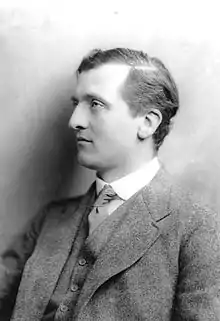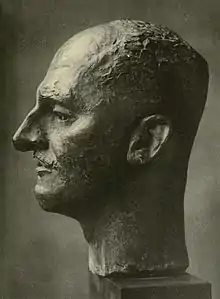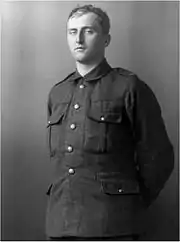T. E. Hulme
Thomas Ernest Hulme (/hjuːm/; 16 September 1883 – 28 September 1917) was an English critic and poet who, through his writings on art, literature and politics, had a notable influence upon modernism.[1] He was an aesthetic philosopher and the 'father of imagism'.[2]
T. E. Hulme | |
|---|---|
 T.E. Hulme in 1912 | |
| Born | Thomas Ernest Hulme 16 September 1883 Endon, Staffordshire, Britain |
| Died | 28 September 1917 (aged 34) Oostduinkerke, West Flanders, Belgium |
| Occupation | Poet, critic |
Early life
Hulme was born at Gratton Hall, Endon, Staffordshire, the son of Thomas and Mary Hulme. He was educated at Newcastle-under-Lyme High School and, from 1902, St John's College, Cambridge, where he read mathematics, but was sent down in 1904 after rowdy behaviour on Boat Race night.[3] He was thrown out of Cambridge a second time after a scandal involving a Roedean girl. He returned to his studies at University College London, before travelling around Canada and spending time in Brussels acquiring languages.
Proto-modernist

From about 1907 Hulme became interested in philosophy,[4] translating works by Henri Bergson[5] and sitting in on lectures at Cambridge. He translated Georges Sorel's Reflections on Violence. The most important influences on his thought were Bergson, who asserted that 'human experience is relative, but religious and ethical values are absolute'[6] and, later, Wilhelm Worringer (1881–1965), German art historian and critic – in particular his Abstraktion und Einfühlung (Abstraction and Empathy, 1908).[7] Hulme was influenced by Remy de Gourmont's aristocratic concept of art and his studies of sensibility and style.[8] From 1909 Hulme contributed critical articles to The New Age, edited by A. R. Orage.
Hulme developed an interest in poetry[9] and wrote a small number of poems. He was made secretary of the Poets' Club, attended by such establishment figures as Edmund Gosse and Henry Newbolt. There he encountered Ezra Pound and F. S. Flint.[10] In late 1908 Hulme delivered his paper A Lecture on Modern Poetry to the club. Hulme's poems "Autumn" and "A City Sunset", both published in 1909 in a Poets' Club anthology,[11] have the distinction of being the first Imagist poems.[12] A further five poems were published in The New Age in 1912 as The Complete Poetical Works of T. E. Hulme.[13] Despite this misleading title, Hulme in fact wrote about 25 poems totalling some 260 lines, of which the majority were possibly written between 1908 and 1910.[14] Robert Frost met Hulme in 1913 and was influenced by his ideas.[15] The publisher of the book 'Ripostes' (to which Pound appended the 'complete' poetical works of T. E. Hulme) spoke in that book of Hulme 'the meta-physician, who achieves great rhythmical beauty in curious verse-forms.'[16]
In his critical writings Hulme distinguished between Romanticism,[17] a style informed by a belief in the infinite in man and nature, characterised by Hulme as "spilt religion", and Classicism, a mode of art stressing human finitude, formal restraint, concrete imagery and, in Hulme's words, "dry hardness".[18][19] Similar views were later expressed by T. S. Eliot.[20] Hulme's ideas had a major effect on Wyndham Lewis (quite literally when they came to blows over Kate Lechmere; Lewis ended the worse for it, hung upside down by the cuffs of his trousers from the railings of Great Ormond Street).[21] He championed the art of Jacob Epstein and David Bomberg, was a friend of Gaudier-Brzeska, and was in on the debut of Lewis's literary magazine BLAST and vorticism.
Hulme's politics were conservative, and he moved further to the right after 1911 as a result of contact with Pierre Lasserre, who was associated with Action Française.
First World War

Hulme volunteered as an artilleryman in 1914 and served with the Honourable Artillery Company and later the Royal Marine Artillery in France and Belgium. He kept up his writing for The New Age. Notable publications during this period for that magazine were "War Notes", written under the pen name "North Staffs", and "A Notebook", which contains some of his most organised critical writing. He was wounded in 1916. Back at the front in 1917, he was killed by a shell at Oostduinkerke near Nieuwpoort, in West Flanders.
[...] On 28 September 1917, four days after his thirty-fourth birthday, Hulme suffered a direct hit from a large shell which literally blew him to pieces. Apparently absorbed in some thought of his own he had failed to hear it coming and remained standing while those around threw themselves flat on the ground. What was left of him was buried in the Military Cemetery at Koksijde, West-Vlaanderen, in Belgium where—no doubt for want of space—he is described simply as 'One of the War poets'."[22]
Works
- Notes on Language and Style (1929, University of Washington Book Store); in The Criterion, Vol. 3, No. 12, (July 1925) (ed. Herbert Read)
- Speculations: Essays on Humanism and the Philosophy of Art (1936, K. Paul, Trench, Trubner & Co., Ltd.), edited by Herbert Read
- Further Speculations of T. E. Hulme (1955, University of Minnesota), edited by Samuel Hynes
- The Collected Writings of T. E. Hulme (1996, OUP), edited by Karen Csengeri
- Selected Writings of T. E. Hulme (2003, Fyfield Books), edited by Patrick McGuinness
Selected poems
- Above the Dock
- Autumn
- A City Sunset
- Conversion
- The Embankment
- Mana Aboda
- The Man in the Crow's Nest
- Susan Ann and Immortality
- The Poet
- A Tall Woman
- A Sudden Secret
- In the Quiet Land
- At Night!
- Town Sky-line
As translator
- Henri Bergson, An Introduction to Metaphysics, (1912)
- Georges Sorel, Reflections on Violence, (1915)
Articles
|
|
|
Notes
- "Though Ezra Pound coined the word "Imagist" and served as chief publicist for the movement, it was the theories supplied by T. E. Hulme which gave the early Imagist experiments their 'authority and direction.' Both men served their common purpose well; together they called the tune for one of the most lively phases of the prewar poetic renascence. With Hulme as metaphysician and Pound as impresario, the Imagists 'did a lot of useful pioneering work. They dealt a blow at the post-Victorian magazine poets... They livened things up a lot. They made free verse popular... And they tried to attain an exacting if narrow standard of style in poetry.' Indirectly they did more. The Imagists, above all other prewar coteries, put into the hands of the poets of the twenties the technical charts and compasses by which to find their poetic way across the hard dry sands of the Wasteland." — Ross, Robert H. (1968). "Sound and Fury." In: Backgrounds to Modern Literature. San Francisco: Chandler Publishing Company, p. 58.
- Hughes, Glenn, 'Imagism & Imagism', Stanford University Press 1931
- "In 1902, Hulme won a mathematics exhibition to St. John’s College, Cambridge. A teetotaler himself, Hulme apparently consorted with some who were not. He was at any rate sent down in 1904 for what Herbert Read delicately called "indulging in a brawl". (A college document that might have slipped out of Bertie Wooster’s dossier mentions "over-stepping the limits of the traditional license allowed by the authorities on Boat Race night.")" — Kimball, Roger (1997). "The Importance of T. E. Hulme," The New Criterion, Vol. XV, p. 18.
- Mead, Henry (2008). "T. E. Hulme, Bergson, and The New Philosophy," European Journal of English Studies, Vol. XII, No. 3, pp. 245–260.
- Gibson, Matthew (2011). "Contradictory Images: The Conflicting Influences of Henri Bergson and William James on T. E. Hulme, and the Consequences for Imagism," Review of English Studies 62, pp. 275–295.
- Pratt, William (1985). Introduction to The Influence of French Symbolism on Modern American Poetry, by Rene Taupin. New York: AMS Press Inc. ISBN 0-404-61579-1
- Jones, Alun R. (1960). "T. E. Hulme, Wilhelm Worringer and the Urge to Abstraction", British Journal of Aesthetics, Vol. I, pp. 1–6.
- Burne, Glen S. (1963). Remy de Gourmont: His Ideas & Influence in England & America. Southern Illinois University Press.
- "It was probably the contrast between the sensory image and a traditional diction that first suggested to T. E. Hulme the isolation of the image. If the image could be identified as the only poetic force within a poem, why not proceed to identify poem and image, as had been the common practice in China or Japan? To cut the cackle – that was to be the first aim of a modern poetry." — Read, Herbert (1955). "The Drift of Modern Poetry," Encounter, Vol. IV, No. 1, p. 6.
- Isaacs, Jacob (1952). "The Coming of the Image," in The Background of Modern Poetry. New York: E. P. Dutton & Co., Inc., pp. 34–51.
- For Christmas MDCCCCVIII (London: The Poets' Club), 1909.
- Schmidt, Michael (1998). Lives of the Poets. London: Weidenfeld & Nicolson ISBN 978-0-297-84014-5
- Hulme, T. E. (1912). "The Complete Poetical Works of T. E. Hulme" (PDF). The New Age. London: The New Age Press Ltd.: 124. They were reprinted, with a short introduction by Pound, in Ripostes of Ezra Pound: Whereto are Appended the Complete Poetical Works of T. E. Hulme (1915). London: Elkin Mathew, pp. 58–64
- Olsen, Flemming (2008). Between Positivism and T. S. Eliot: Imagism and T.E. Hulme. Studies in Literature, Vol. 52. Odense: University Press of Southern Denmark. p. 124. ISBN 978-87-7674-283-6.
- Hoffman, Tyler (2001). Robert Frost and the Politics of Poetry. University Press of New England, p. 54 ISBN 1-58465-150-4
- Appendix to Ripostes, Stephen Swift & Co., Ltd., 1912.
- Krieger, Murray (1953). "The Ambiguous Anti-Romanticism of T. E. Hulme," ELH, Vol. 20, No. 4, pp. 300–314.
- Hulme, T. E. (2003). "Romanticism and Classicism." In: Selected Writings. Ed. Patrick McGuinness. New York: Routledge, pp. 68–83.
- Hadjiyiannis, Christos (2013). "Romanticism versus Classicism in 1910: T. E. Hulme, Edward Storer and The Commentator," Literature and History, Vol. XXII, No. 1, pp. 25–41.
- "The English critic and philosopher T. E. Hulme had written, in the years immediately preceding his death in World War I in 1917, a series of essays in which he attacked the subjectivism and vagueness of romantic literature and advocated "dry and hard" images in poetry as well as objectivity and discipline in art in general. Hulme believed that "man is by nature bad or limited, and can consequently only accomplish anything of value by disciplines, ethical, heroic or political", and he saw one consequence of this belief as an abandonment of romantic optimism about the nature and potentialities of man. Hulme's views influenced T. S. Eliot and are reflected in Eliot's influential essay, Tradition and the Individual Talent, which first appeared in 1917." — Daiches, David (1962). "The New Criticism." In: Time of Harvest, American Literature, 1910–1960. New York: Hill and Wang, p. 96.
- McGuinness, Patrick (1998), Ed. T. E. Hulme: Selected Writings. Manchester: Fyfield Books, p. xvi.
- Ferguson, Robert (2002). The Short Sharp Life of T. E. Hulme. London: Allen Lane, p. 270.
Further reading
- Beasley, Rebecca (2007). Theorists of Modernist Poetry. T. S. Eliot, T. E. Hulme, Ezra Pound. London: Routledge.
- Belgion, Montgomery (1927). "In Memory of T. E. Hulme," The Saturday Review, Vol. IV, No. 10, pp. 154–155.
- Brookner, Jewel Spears, (1984). T. E. Hulme and Irving Babbitt: An Annotated Bibliography. New York: Garland.
- Coffman, Stanley K., Jr. (1951). Imagism: A Chapter for the History of Modern Poetry. University of Oklahoma Press.
- Collin, W. E. (1930). "Beyond Humanism: Some Notes on T. E. Hulme," The Sewanee Review, Vol. 38, No. 3, pp. 332–339.
- Comentale, Edward P.; Andrzej Gasiorek (2013). T. E. Hulme and the Question of Modernism. Aldershot: Ashgate Publishing, Ltd.
- Csengeri, K. E. (1982). "T. E. Hulme's Borrowings from the French," Comparative Literature, Vol. 34, No. 1, pp. 16–27.
- Eliot, T. S. (1932). Selected Essays, 1917-1932. London: Faber and Faber.
- Epstein, Jacob (1955). "T.E. Hulme and his Friends." In: Epstein: An Autobiography. New York: E.P. Dutton & Company, pp. 59–62.
- Ferguson, Robert (2002). The Short Sharp Life of T. E. Hulme. London: Allen Lane
- Flint, F. S. (1915). "The History of Imagism," The Egoist, Vol. II, No. 5, pp. 70–71.
- Hadjiyiannis, Christos (2013). "Ezra Pound, T. E. Hulme, Edward Storer: Imagism as Anti-Romanticism in the Pre-Des Imagistes Era". In: Imagism: Essays on its Initiation, Impact and Influence. Ed. John Gery, Daniel Kempton, and H. R. Stoneback, The University of New Orleans Press, pp. 35–46.
- Harmer, J. B. (1975). Victory in Limbo: Imagism 1908-1917. London: Secker & Warburg.
- Hoeres, Peter (2003). "T. E. Hulme - Ein konservativer Revolutionär aus England", in: Zeitschrift für Politik, 50, pp. 187–204.
- Hughes, Glenn, (1931). Imagism and the Imagists. Stanford, CA.: Stanford University Press.
- Jones, Alun (1960). The Life and Opinions of T. E. Hulme. London: Victor Gollancz.
- Kamerbeek, Jr., J. (1969). "T. E. Hulme and German Philosophy: Dilthey and Scheler," Comparative Literature, Vol. 21, No. 3, pp. 193–212.
- Kishler, Thomas C. (1976). "Original Sin and T. E. Hulme's Aesthetics," Journal of Aesthetic Education, Vol. 10, No. 2, pp. 99–106.
- Kuhn, Elizabeth (2011). "Toward an Anti-Humanism of Life: The Modernism of Nietzsche, Hulme and Yeats," Journal of Modern Literature, Vol. 34, No. 4, pp. 1–20.
- Levenson, Michael H. (1984). A Genealogy of Modernism. A Study of English Literary Doctrine 1908-1922. Cambridge University Press.
- Litz, A. Walton (2000). Modernism and the New Criticism. Cambridge University Press.
- Nott, Kathleen (1954). "Mr. Hulme's Sloppy Dregs." In: The Emperor Clothes. London: William Heinemann Ltd., pp. 56–104.
- Orage, A. R. (1920). "Readers and Writers," The New Age, Vol. XXVII, No. 17, pp. 259–260.
- Paige, D. D. (1951). The Letters of Ezra Pound, 1907-1941. London: Faber and Faber.
- Rackin, Phyllis (1967). "Hulme, Richards, and the Development of Contextualist Poetic Theory," The Journal of Aesthetics and Art Criticism, Vol. 25, No. 4, pp. 413–425.
- Rae, Patricia (1997). The Practical Muse. Pragmatist Poetics in Hulme, Pound, and Stevens. Bucknell University Press.
- Read, Herbert (1953). "The Isolation of the Image: T.E. Hulme." In: The True Voice of Feeling. London: Faber & Faber, pp. 101–115.
- Roberts, Michael (1938). T. E. Hulme. London: Faber & Faber (Rep. by Carcanet Press, 1982).
- Salter, K. W. (1965). "Traherne and a Romantic Heresy." In: Thomas Traherne: Mystic And Poet. New York: Barnes and Noble, Inc., pp. 130–135.
- Schuchard, Ronald (2003). "Did Eliot Know Hulme? Final Answer," Journal of Modern Literature, Vol. 27(1/2), pp. 63–69.
- Shusterman, Richard (1985). "Remembering Hulme: A Neglected Philosopher-Critic-Poet," Journal of the History of Ideas, Vol. 46, No. 4, pp. 559–576.
- Tatham, Jr., Lewis Charles (1965). "T. E. Hulme." In: Shelley and his Twentieth-Century Detractors. (M.A. Thesis) University of Florida.
- Tigani, Francesco (2016). "Fra immaginazione e realtà: dalla critica del Romanticismo alla teologia politica negli scritti di Thomas Ernest Hulme e Carl Schmitt'", Información Filosófica, XIII, pp. 91–110.
- Tindall, William York (1955). The Literary Symbol. Columbia University Press.
- Wilhelm, J. J. (2010). Ezra Pound in London and Paris, 1908–1925. Penn State Press ISBN 0271040998
- Williams, Raymond (1960). "T. E. Hulme." In: Culture & Society 1780-1950. New York: Doubleday & Company, Inc., pp. 205–210.
External links
- Works by T. E. Hulme at Project Gutenberg
- Works by or about T. E. Hulme at Internet Archive
- Works by T. E. Hulme at LibriVox (public domain audiobooks)

- Critical discussion of Hulme's work, including texts of 16 poems (Univ. of Southern Denmark)
- List of manuscript and typescript poems, etc. held at Keele University Library
- Romanticism and Classicism
- A Note on the Art of Political Conversion
- ‘A Definite Meaning’: The Art Criticism of T. E. Hulme
- The Evolution of T. E. Hulme's Thought
- T. E. Hulme: The First Conservative of the Twentieth Century
- Hulme Reconsidered and Reappreciated